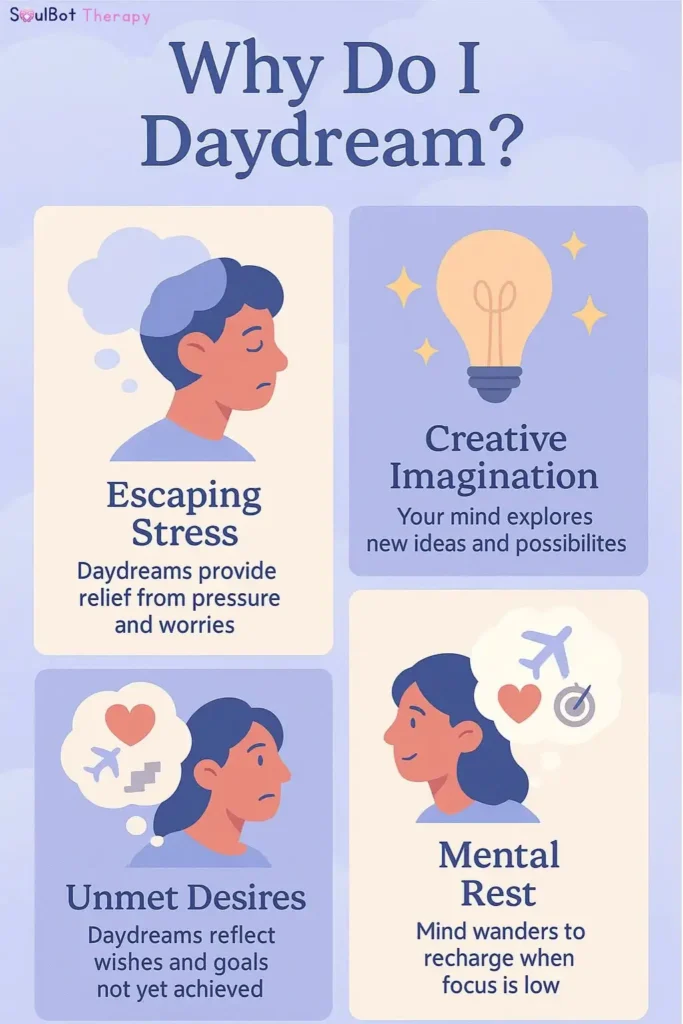Do you often find your mind drifting off in the middle of work, conversations, or even while reading? Daydreaming can be a pleasant escape, but when it happens too often, it can interfere with productivity and emotional well-being. In fact, research suggests that we spend nearly half of our waking hours lost in thought. It’s our brain’s way of processing emotions, solving problems, and escaping stress.
If you’re searching for how to stop daydreaming, you’ve come to the right place. Let’s explore why our minds wander, when it becomes harmful, and practical ways to stay grounded and focused.
🤔 Why Do We Daydream So Much?
Daydreaming is a natural part of the human mind; it’s your brain’s way of exploring ideas, solving problems, or simply escaping boredom. But excessive daydreaming can happen when your brain is overstimulated, anxious, or under-challenged.
Some common triggers include:
➔💭 Stress or anxiety: Overthinking vs daydreaming often blur when your worries fuel imaginative escapes.
➔ 😐 Boredom or lack of stimulation: Your mind seeks entertainment when tasks feel monotonous.
➔ 🔄 Habitual patterns: Some people unconsciously retreat into fantasy to cope with emotional discomfort.
Is Excessive Daydreaming Harmful for Mental Health?
While occasional daydreaming can be beneficial, excessive daydreaming can interfere with life responsibilities, relationships, and mental clarity. Signs it might be harmful include:
| Sign | Why It Matters |
| Distraction | • Tasks take longer • Work may remain unfinished |
| Social withdrawal | • Miss out on real-life interactions • Reduced social engagement |
| Emotional distress | • Feelings of guilt or anxiety • Lowers overall mental well-being |
| Daydreaming & anxiety | • Fantasies can amplify worries • Increases mental clutter |
💡 SoulFact: According to Verywell Mind – Maladaptive Daydreaming, excessive daydreaming can overlap with anxiety or ADHD, making professional guidance helpful in extreme cases.

🎯 How to Stop Daydreaming and Stay Focused?
The good news is that staying present is possible with intentional practice. Here are actionable ways to regain mental focus:
- Recognize your triggers
- ✔ Notice when and why your mind starts to wander.
- ✔ Journaling moments of distraction can uncover patterns.
- Set structured focus periods
- ✔ Try the Pomodoro Technique: 25 minutes work + 5 minutes break.
- ✔ Clear goals reduce the temptation for mind wandering.
- Ground yourself physically
- ✔ Deep breaths, stretching, or touching textured objects anchor you in the present.
- Use mental anchors
- ✔ Repeat a mantra or count breaths/steps to redirect attention.
- Limit digital distractions
- ✔ Turn off notifications and schedule social media or news breaks outside work hours.
SoulTip: Studies show that even 5 minutes of conscious refocusing reduces wandering thoughts and improves task completion.
What’s the Role of Mindfulness in Staying Present?
Mindfulness to stay present is about training the mind to acknowledge thoughts without getting lost in them. Techniques include:
- Meditation: 5–10 minutes daily reduces mental wandering.
- Body Scan: Focus on sensations from head to toe.
- Mindful Breathing: Anchors attention to breath, breaking cycles of overthinking.
When practiced regularly, mindfulness strengthens the brain’s ability to notice drifting thoughts and gently redirect focus, effectively helping how to stop daydreaming.
Best Mental Focus Techniques for Overthinkers
If you often confuse overthinking vs daydreaming, these techniques to stop daydreaming at work can help:
- ⏱️ Pomodoro Technique: 25-minute work sessions + 5-minute breaks.
- 💡 Visualization Anchors: Mentally picture completing a task to stay motivated.
- 🖼️ Task Prioritization: Write down three critical tasks per day.
- 📚 Journaling: Empty the mind of recurring thoughts before work.
- 🏃 Movement Breaks: Short walks or stretches improve attention and reduce mental fatigue.
| Technique | Benefit | Recommended Time |
| Pomodoro | Sustained attention | 25 min focus + 5 min break |
| Mindfulness | Reduced anxiety | 10 min daily |
| Journaling | Clears intrusive thoughts | 5–10 min |
| Visualization | Enhances motivation | 5 min before tasks |
| Movement | Re-energizes brain | 3–5 min every hour |
💡 SoulFact: APA research suggests that while brief daydreaming can enhance creativity, excessive mind-wandering may impair focus and productivity.
How to Try These at Home?
You don’t need a professional therapist to regain control over wandering thoughts:
- ✦ Start a morning mindfulness exercise for overthinking for 5–10 minutes.
- ✦ Keep a focus journal tracking daydream frequency.
- ✦ Pair work sessions with intentional breathing or grounding exercises.
- ✦ Experiment with ambient noise or low music to improve concentration.
🌟Closing Thoughts: Regain Your Focus and Presence
Learning how to stop daydreaming isn’t about eliminating imagination; it’s about controlling when and where your mind wanders. By understanding triggers, practicing mindfulness, and applying mental focus techniques, you can reduce excessive daydreaming, calm anxious thoughts, and boost productivity.
Start small: Notice daydreams, try grounding strategies, and integrate mindfulness into your routine.
👉 Want personalized strategies to stay present? Chat with SoulBot, your AI focus coach, for tailored tips on managing wandering thoughts and improving mental clarity.







